Keywords
Maternal perception; Disciplinary practices; Child Maltreatment; Vignette
Introduction
Disciplining is a major component of parenting. The word discipline origin from ‘disciplinare’ and it means ‘to teach’ or ‘to instruct’. The formal definition of disciplining refers to the system of teaching and nurturing that prepares children to achieve competence, self-control, self-direction and caring for others [1]. The word discipline also refers to the strategies used for elimination or reduction of undesirable behaviours. The disciplining strategies are of two types; extinction and punishment. Extinction includes time-out and removal of privileges. Punishment is two types; verbal reprimands and inflicting physical pain [1]. Positive strategies of disciplining strengthen the ability of child to behave appropriately while building positive relationships. Punishments express the anger or desperation of care giver [2].
The physical and psychological abusive acts towards the children more often occurs in the means of punishment [2,3]. It affects physical, psychological, cognitive, and behavioral development of children. Physical consequences range from minor injuries to severe brain damage and even death. Psychological consequences range from chronic low self-esteem to severe dissociative states. The cognitive effects of abuse range from attention problems and learning disorders to severe organic brain syndromes. Behaviorally, the consequences of abuse range from poor peer relations to extraordinarily violent behaviors [1-3].
Parental attitudes, beliefs and perceptions play a key role in shaping the disciplinary practice and many factors influence those attitudes and beliefs. Those are parental personality partic, family, neighborhood context and cultural aspects [4-6].
According to available literature several underlying factors support the existence and use of harmful disciplinary practices. Those include perceived effectiveness and efficacy associated with preferred disciplinary approach, parental childhood experience, social norms that tolerate violence towards children, social norms regarding disciplining, varying beliefs about violence and belief in the value of physical discipline [7-10]. Parents’ belief on the physical punishment such as tolerance and approval is associated with parenting stress [11].
Parents’ childhood experience of physical abuse might reinforce acceptance of violence as an appropriate and acceptable means of discipline [8,12]. Disciplinary attitudes play an important role in intergenerational pattern of abuse. Family history appears to play a critical role in shaping such disciplinary beliefs [13]. Corporal punishment is also viewed as a right of parents and considered a duty to instill filial piety in their children [14].
Personal experience and perceptions are important factors in selecting a disciplinary strategy. Furthermore, increase in approval and acceptance of physical disciplinary strategies can be observed when parents have experienced those [15,16]. Some who had been severely abused in their childhood did not judge those acts as abusive [17]. Also the children who grew up in abusive homes considered violent disciplinary acts as normal compared to their normal counterparts. Abusive parents use severe forms of physical disciplinary strategies frequently [13,18]. Notably some parents believe that severity of the physical disciplinary act depends on the perceived culpability of the child [16]. Therefore, in certain occasions harsher disciplinary practices are considered as less severe [18,19].
There have been previous attempts to investigate the attitudes towards disciplinary practices. Those studies tried to find parent view on abusiveness of a given disciplinary act [17]. Parental rating on severity, effectiveness, approval, appropriateness, harshness and abusiveness has been also studied [7,13,16,20]. Few studies tried to capture the disciplinary attitudes of the professionals [12,21,22].
Studies on the prevalence of physical and psychological disciplinary act towards the children are available in Sri Lanka [23,24]. However, studies to quantify the parental perception on severity, approval and harm towards a particular disciplinary act are rare. Objective of this study was to develop an instrument and assess maternal perception of severity, approval and harm towards the physical and psychological disciplinary practices in a rural community of Sri Lanka.
Method
The methodology comprise of two components: (1) development of an instrument to measure parental perception and (2) field testing of the instrument. A three step process was followed in the development of the instrument.
In the step one, a literature search was done to identify different categories of disciplinary practices and common methods used. In general three categories were identified; non violent disciplinary practices, physical disciplinary practices and psychological disciplinary practices [3,25]. Those disciplinary practices are also common in Sri Lanka [23,24].
During the second step, an item generation was done to identify the commonly used disciplinary practices in the Sri Lankan rural setting alone with the circumstances. Focus Group Discussions (FGD), In-depth interviews with key informants and direct observations in a rural community in Sri Lanka were performed. Field health staff, school teachers, local administrative officers, village leaders and parents were selected purposely for in-depth interviews and FGDs. Verbal consent to record the interview was obtained from each participant. A semi structured interviewer guide was used for the interviews. Narratives on disciplinary situations and common methods was recorded and transcribed to generate the item pool.
The vignettes were developed considering physical and psychological disciplinary acts of parents, day-to-day normal events occurring between children and parents, non-violent disciplinary practices used by parents and healthy parent child interactions. Normal events were included to be used as check items. Using the information obtained from the in-depth interviews & FGDs totally 46 items were developed.
In the third step, a panel consisting of three professionals related to health, legal and social work familiar with child maltreatment assessed the item pool. All the generated items according to different disciplinary practices were presented to the panel for ranking. The participants individually ranked the items considering the suitability of them to be included in the instrument. Following the first round of ranking a discussion was held to reason out the order of ranking and to obtain suggestions to modify the items if needed. The top 10 items for each category was selected and items were modified if suggested. Same procedure was continued for three rounds till consensus was achieved to enhance the validity of the tool [26].
Finally out of 46 items 20 items were selected for the scale. Eight items from each category to assess perceptions on physical and psychological disciplinary practices and 4 items on normal situations were included. The items were presented as vignettes on different disciplinary practices and incorporated to a 10 point visual analogue scale. The scale was named Parental Perception on Disciplinary Practices Scale (PPDPS).
The instrument was designed to measure three domains severity, approval and harm of parental perceptions on a particular disciplinary action. They were measured separately using three visual analog scales for each vignette. The scale ranged from ‘less negligible’ to ‘profound’ when measuring severity and harm and ‘not approved at all’ to ‘highly approved’ when measuring approval of the act by the parent.
Mothers of children in the age group of 11-16 years in two villages of Anuradhapura district were selected for the study. List of households in the villages was obtained from the village level administrative officer (Grama Niladhari) and those families with children aged 11-16 years were identified. Of 79 eligible households in both villages and 67 mothers participated. Response rate was 84.9%. Informed verbal consent was obtained before administering the questionnaire. To minimize the effects of different literacy levels interviewer administered questionnaire was used. At the beginning all 20 vignettes written in a set of cards were read to the participants. They were asked to select those vignettes into three categories; incidents that they perceived as physical disciplinary acts, psychological disciplinary acts and normal events. Ability of mothers to identify a given disciplinary act in respect to those three categories was recorded. Then the respondents were asked to mark their perceptions on severity, harm and approval of each of correctly selected disciplinary act on the visual analog scale ranged from 0-10.
Number of correctly selected vignettes in physical and psychological disciplinary categories was presented as frequencies. Mean scores and standard deviations were calculated for perceive severity, approval and harm for each disciplinary act. Then weighted mean scores were calculated for total physical and psychological disciplinary acts in relation to three domains. Correlation was examined between the perception of severity and approval, perception of severity and harm, perception of harm and approval for each of the physical and psychological disciplinary act.
The study was conducted in 2011 and clearance was obtained from ethics review committee, Faculty of Medicine, University of Colombo, Sri Lanka.
Results
Mean age of the mothers was 36.93 (SD=6.11). All the participants were Sinhalese. Average number of children in the family was 2.46 (SD=0.84) and average number of daughters and sons in the family was 1.27 (SD=0.93) and 1.19 (SD=0.96) respectively. Median monthly household income of the family was US$117 (Table 1).
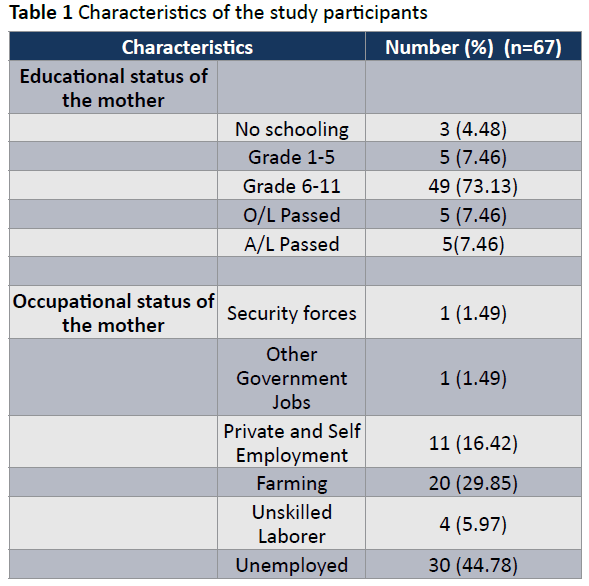
Table 2 shows the correct selection of vignettes on physical and psychological diciplinary actions by mothers. Vignetts on normal events is not presented .
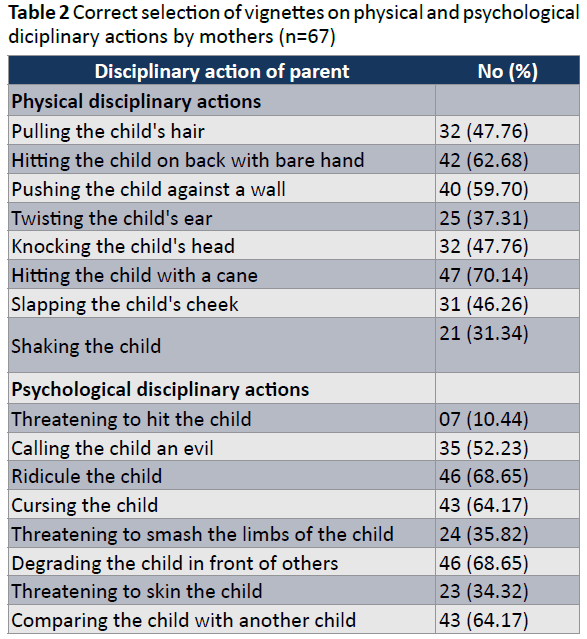
The possible values for the visual analog scale range from 1 to 10. In relation to perception of severity and harm, higher values denote that the mother perceives a particular disciplinary act to be sever and more harmful to the child. For perception of approval, higher values denote that the mother approves usage of such acts in disciplining her children.
The mean scores of mother’s perception of severity, harm and approval on physical disciplinary acts is presented in Table 3.
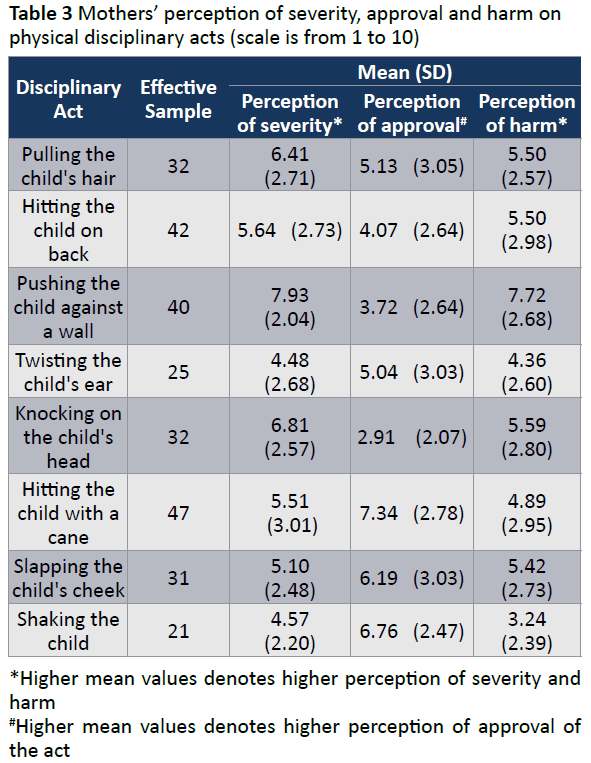
The mean scores for perception of severity for eight individual physical disciplinary acts varied from 4.57 to 7.93 and for harm from 3.24 to 7.72. Mean scores for perception of approval varied from 2.91 to 7.34.
The mean scores of mother’s perception of severity, harm and approval on individual psychological disciplinary acts is presented in Table 4. The mean scores for perception of severity varied from 4.29 to 7.52 and for harm varied from 4.43 to 7.39. Mean scores for perception of approval on psychological disciplinary acts varied from 3.06 to 5.43.
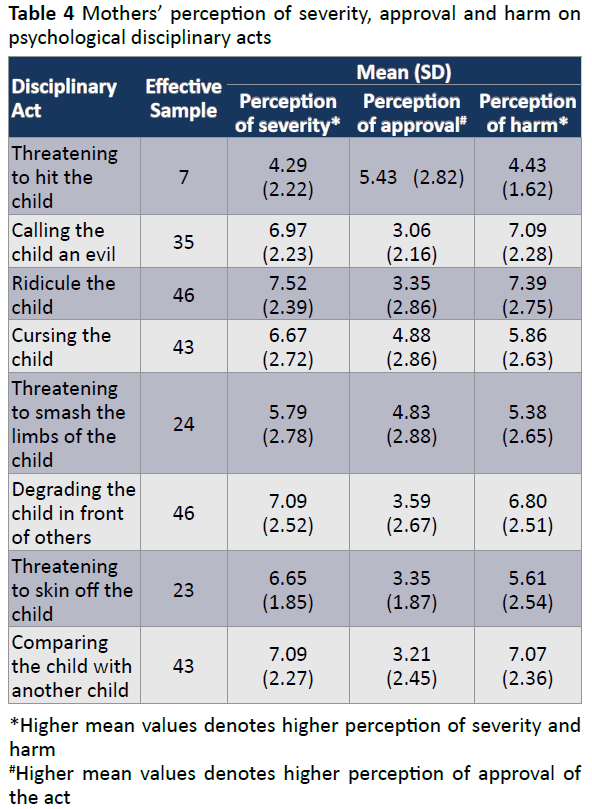
The weighted mean scores were calculated separately for severity, harm and approval to provide a composite measure for the two major categories of physical and psychological disciplinary acts. Mean scores were 5.93, 5.44, 5.12, and 6.85, 6.54, 3.76, respectively.
Correlation between mother’s perception of severity and approval, severity and harm and approval and harm for physical and psychological disciplinary acts are presented in Tables 5 and 6.
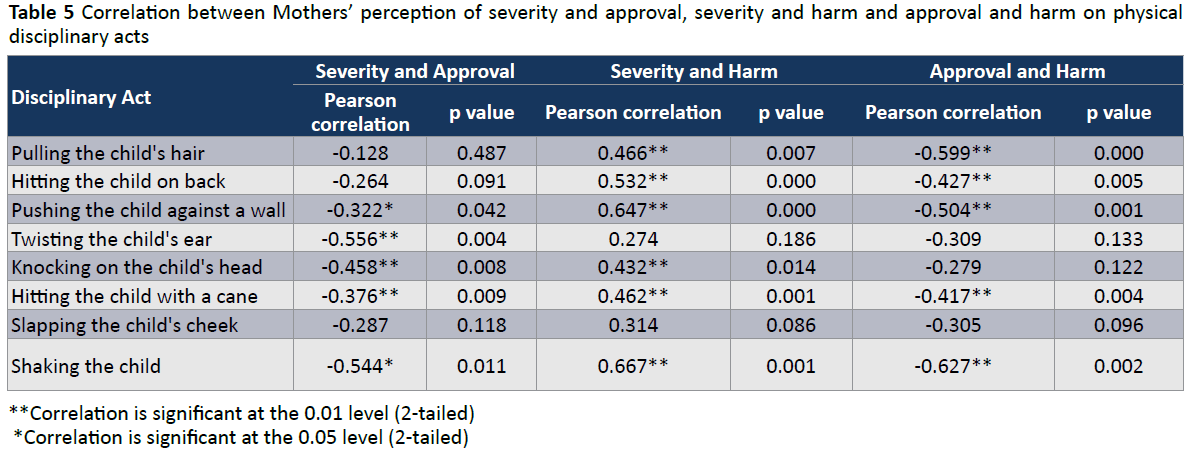
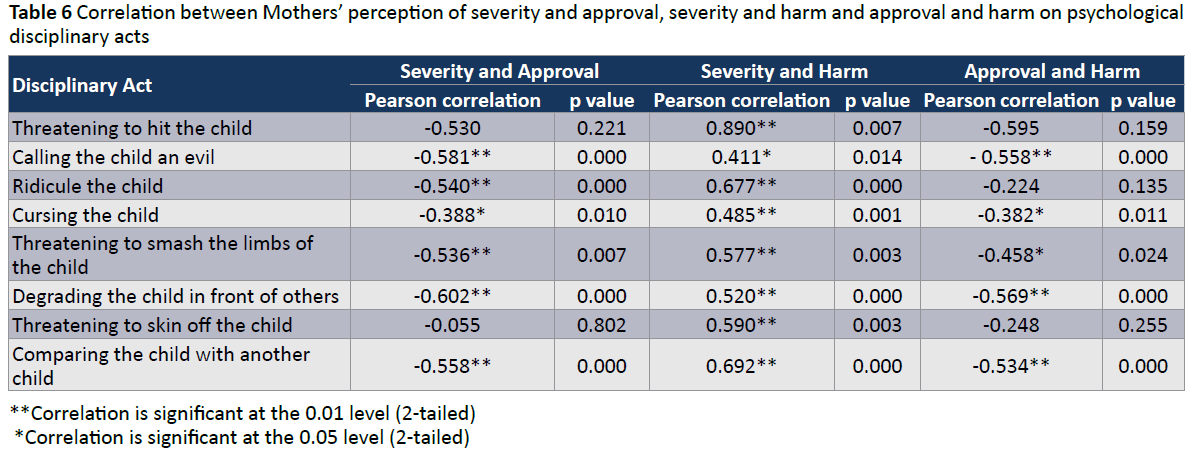
Negative correlation was observed between maternal perception on severity and approval. Also a negative correlation was seen between harm and approval for all physical and psychological disciplinary acts. A positive correlation was reported between perception on severity and harm for both acts.
Discussion
The study found that physical disciplinary acts were perceived as less punitive compared to the psychological disciplinary acts by mothers. Negative correlation was observed for the perception of approval with perception of severity and harm. Mothers had favorable perceptions towards physical disciplinary practices compared to psychological disciplinary practices.
As stated above this study intended to address the need of generating epidemiological information on child maltreatment which is still rare worldwide [2]. Disciplinary practices are the main cause for physical and psychological maltreatment of children. Lack of information has hampered the development of planning and evaluation strategies on this issue [2,3]. A parental perception on the disciplinary practices is a crucial factor for successful implementation of any intervention.
Vignettes are used as a research tool to capture the knowledge and attitudes, opinions and beliefs of a person particularly on sensitive phenomenon [27,28]. Vignettes based questionnaire with a rating scales has been used in a number of previous studies too to measure parental attitudes towards the disciplinary acts and child maltreatment acts [13,16,22,29,30].
As disciplinary practices are culture bound, the study instruments need to be culture sensitive. Hence, we used a broad base consultative process to generate items. A similar method has been used in other studies too [16,30]. Further, we adhered to the WHO categorization in selecting the disciplinary acts [3]. This enable the generic instrument developed to be useful across different communities. The vignettes in this instrument can be replaced with suitable alternatives accordingly to the local setting. However, the vignettes were not developed to be gender neutral. Hence, maternal perception of severity, approval and harm in respect of the gender of the child might not be captured.
The vignettes comprised of physical and psychological disciplinary acts as well as normal events occur between parent and child. They were developed to present the parental act itself than the consequence of the act. As physical disciplinary acts cause both physical maltreatment and psychological maltreatment, it was necessary to present the ‘act’ in its pure form to elicit the perception. Perceived culpability of the child also affects the parent’s perception on severity towards a particular disciplinary act. Therefore, vignettes were designed in a way to present child’s culpability in a gradient.
According to a study done in 2005 [3] parental behaviors was categorized as no abuse, physical, emotional or sexual abuse. The abusiveness of parental behavior was rated in a likert scale from 0 to 7. In a Canadian study on physical and psychological disciplinary acts of parents, a 6 point likert scale ranging from ‘appropriate to a large extent’ to ‘inappropriate to large extent’ was used [30]. We used 10 point visual analog scales to improve the applicability in a mixed literate population. It is known that visual analog scales are useful for obtaining ordinal preferences [31].
Findings of this study demonstrated the ability of the instrument to capture different levels of perceptions of severity, harm and approval across different items. Changes that occur in human behavior are generally slow and incremental. When examining changes in established practices, usage of objective method to measure the changes over time is useful in evaluating programme success. An added advantage of this instrument is the ability to measure three domains of perceptions using a single item.
Findings of the study, shows less number of mothers had perceived “shaking child” and “twisting the child’s ear” as physical disciplinary acts. Those two acts reported the lowest mean scores for perception of severity and harm suggesting mothers perceive those acts to be less punitive. Similarly in a study conducted in Turkey, “shaking the child” was not recognized as reportable abuse and participants considered it as acceptable [12]. The act of “pushing the child against wall” was perceived as the most severe and harmful act by the mothers in our study. Although highest number of mothers recognized “hitting the child with a cane” as a physical disciplinary act they also approved it giving the highest rank. In previous studies too participants viewed “beating” as an acceptable form of disciplining in the study done in Turkey [12].
Only the 10% of mothers viewed “threatening to hit the child” as a psychological disciplinary act. Of all the acts it was considered as the least severe, highly approved and least harmful. In line with that no significant correlation was found between perception of severity and approval and perception of harm and approval for that particular act. However, negative correlation was observed for all the other acts with respect to perception of approval with severity and harm. Further, two other acts were also not considered as psychological disciplinary acts by most mothers. Those include “threatening to skin off the child” and “threatening to smash the limbs of the child”. Hence, the findings suggest that psychological disciplinary acts which are threatening physical harm to the child were perceived as less punitive by the mothers. Mean scores of severity and harm for highly approved acts were low indicating that those were perceived as less punitive [22]. However, in comparison to psychological disciplinary acts, overall mean scores of physical acts on severity and harm was low with high approval rates. This suggests that mothers in this community consider physical disciplinary acts to be less punitive. This very fact may be influencing the community norm to sustain severe forms of physical punishment methods.
Conclusions
The findings of the study demonstrate that mothers in this community favour physical disciplinary practices compared to the psychological disciplinary practices. Even though the perceived culpability of the child is low in the psychological disciplinary acts they perceive those acts as comparatively severe, harmful and less approved. This difference of perception needs further attention.
Use of vignettes derived from the community in conjunction with a visual analogue scale is shown to be an effective tool to assess perceptions. Further, the inherent flexibility of the tool that allows replacing appropriate vignette in cross cultural application increases the utility. Hence, Parental Perception on Disciplinary Practices Scale (PPDPS) can be a useful instrument in child maltreatment research.
6530
References
- American Academy of Pediatrics (1998) Committee on Psychosocial Aspects on Child and Family Health. Guidance for effective discipline. Pediatrics 101: 723-728
- Butchart A, Harvey AP, Main M, Furniss T (2006) Preventing child maltreatment: a guide to taking action and generating evidence. World Health Organization and International Society for Prevention of Child Abuse and Neglect, Geneva
- World Health Organization (2002) World Report on Violence and Health. World Health Organization, Geneva
- Giles-Sims J, Lockhart C (2005) Culturally Shaped Patterns of Disciplining Children. Journal of Family Issues 26: 196-218
- Dietz TL (2000) Disciplining children: characteristics associated with the use of corporal punishment. Child Abuse Negl 24: 1529-1542
- Tang CS (2006) Corporal punishment and physical maltreatment against children: a community study on Chinese parents in Hong Kong. Child Abuse Negl 30: 893-907
- Thompson RA, Christiansen EH, Jackson S, Wyatt JM, Colman RA, et al. (1999) Parent Attitudes and Discipline Practices: Profiles and Correlates in a Nationally Representative sample. Child Maltreatment 4: 316-330
- Maker AH, Shah PV, Agha Z (2005) Child Physical Abuse : Prevalence, Characteristics, Predictors, and Beliefs About Parent-Child Violence in South Asian, Middle Eastern, East Asian, and Latina Women in the United States. J Interpers Violence 20: 1406-1428
- Barkin S, Scheindlin B, Ip EH, Richardson I, Finch S (2007) Determinants of Parental Discipline Practices: A National Sample from Primary Care Practices. ClinPediatr 46: 64-69
- Klevens J, Whitaker DJ (2007). Primary Prevention of Child Physical Abuse and Neglect: Gaps and Promising Directions. Child Maltreat 12: 364-377
- Crouch J L, Behl LE (2001) Relationships among parental beliefs in corporal punishment, reported stress, and physical child abuse. Child Abuse Negl 25: 413-419
- Orhon FS, Ulukol B, Bingoler B, Gulnar SB (2006) Attitudes of Turkish parents, pediatric residents and medical students toward child disciplinary practices. Child Abuse Negl 30: 1081-1092
- Bower-Russa, M (2005) Attitudes Mediate the Association Between Childhood Disciplinary History and Disciplinary Responses. Child Maltreat 10: 272-282
- Dunne MP, Chen JQ, Wan Yuen Choo (2008) The evolving evidence base for child protection in Chinese societies. Asia Pac J Public Health 20: 267-276
- Buntain-Ricklefs JJ, Kemper KJ, Bell M, Babonis T (1994) Punishments: what predicts adult approval. Child Abuse Negl 18: 945-955
- Rodriguez CM, Sutherland D (1999) Predictors of parents' physical disciplinary practices. Child Abuse Negl 23: 651-657
- Bower ME, Knutson JF (1996) Attitudes toward physical discipline as a function of disciplinary history and self-labeling as physically abused. Child Abuse Negl 20: 689-699
- Trickett PK, Kuczynski L (1986) Children’s Misbehaviors & Parental Discipline Strategies in Abusive & Non Abusive Families. DevPsychol 22: 115-123
- Kelder LR, McNamara JR, Carlson B, Lynn SJ (1991) Perceptions of physical punishment: The relation to childhood and adolescent experiences. J Interpers Violence 6: 432–445
- Jackson S, Thompson RA, Christiansen EH, Colman RA, Wyatt J, et al. (1999) Predicting abuse-prone parental attitudes and discipline practices in a nationally representative sample. Child Abuse Negl 23: 15-29
- Segal UA (1992) Child abuse in India: an empirical report on perceptions. Child Abuse Negl 16: 887-908
- Ashton V (2001) The relationship between attitudes toward corporal punishment and the perception and reporting of child maltreatment. Child Abuse Negl 25: 389-399
- deZoysa, Rajapakse L, Newcombe PA (2005) Adaptation and validation of the parent-child conflict tactics scale for use in Sri Lanka. Ceylon Med J 50: 11-14
- Perera B, Ostbye T, Ariyananda PL, Lelwala E (2009) Prevalence and correlates of physical and emotional abuse among late adolescents. Ceylon Med J 54: 10-15
- Stratus MA, Hamby SL, Finkelhor D, Moore DW, Runyan D (1998) Identification of child maltreatment with the parent child conflict tactics scale: development and psychometric data for a national sample of American parents. Child Abuse Negl 22: 249-270
- Abramson JH, Abramson ZH (1999) Survey methods in community medicine. (5thedn), Churchill Livingstone, London
- Hughes R, Huby M (2002) The application of vignettes in social and nursing research. J AdvNurs 37: 382-386
- Gould D (1996) Using vignettes to collect data for nursing research studies: how valid are the findings? J ClinNurs 5: 207-212
- Pinderhughes EE, Dodge KA, Bates JE, Pettit GS, Zelli A (2000) Discipline Responses: Influence of Parents’ Socioeconomic Status, Ethnicity, Beliefs About Parenting, Stress, and Cognitive-Emotional Processes. J FamPsychol 14: 380-400
- Maiter S, Alaggia R, Trocmé N (2004) Perceptions of Child Maltreatment by Parents from the Indian Subcontinent: Challenging Myths about Culturally Based Abusive Parenting Practices. Child Maltreat 9: 309-324
- Torrance GW, Feeny D, Furlong W (2001) Visual analog scales: do they have a role in the measurement of preferences for health states? Med Decis Making 21: 329-334











